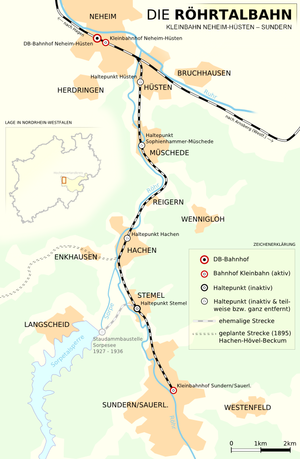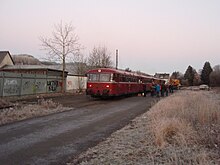Neheim-Hüsten – Sundern railway line
| Neheim-Hüsten-Sundern | |||||||||||||||||||||||||||||||||||||
|---|---|---|---|---|---|---|---|---|---|---|---|---|---|---|---|---|---|---|---|---|---|---|---|---|---|---|---|---|---|---|---|---|---|---|---|---|---|
| Route number : | 9283 | ||||||||||||||||||||||||||||||||||||
| Course book section (DB) : | 238 a (1966) | ||||||||||||||||||||||||||||||||||||
| Route length: | 14.2 km | ||||||||||||||||||||||||||||||||||||
| Gauge : | 1435 mm ( standard gauge ) | ||||||||||||||||||||||||||||||||||||
|
|||||||||||||||||||||||||||||||||||||
The Neheim-Hüsten-Sundern railway line is the normal-gauge branch line from Neheim - Hüsten to Sundern in the Hochsauerlandkreis . It leads from Hüsten in the Ruhr valley , today part of the city of Arnsberg , in a southerly direction through the Röhr valley to the central town of Sundern. It is also known regionally as the Röhrtalbahn, or RTB for short.
history
Neheim-Hüsten – Sundern small railway
The 14-kilometer route with the VzG route number 9283 was opened on June 1, 1900 by the West German Railway Company as the third small - scale rail line starting from Neheim via Hüsten. Up until the First World War there were concrete plans to extend the route. This should lead via Allendorf to Finnentrop .
It came as part of the reorganization of the AG for Transport in 1925 to its subsidiary Vereinigte Kleinbahnen AG and was then operated by the Deutsche Eisenbahn-Gesellschaft. For passenger transport, among others, was railcars NHS T1 used.
To build the Sorpe Dam, a track was built from Stemel to the dam construction site, which was dismantled after completion.
Ruhr-Lippe Railways
In 1978 the AG Ruhr-Lippe-Eisenbahnen (RLE) took over the Röhrtalbahn, and with it it came to Regionalverkehr Ruhr-Lippe GmbH (RLG) in 1979 . Both transport companies are run by municipalities and local authority associations in North Rhine-Westphalia.
Because of the dense settlement of the valley and its numerous industrial companies, the volume of traffic on the Röhrtalbahn always reached a considerable level, so that it could be operated as a profitable private railway for a long time.
On April 20, 1966, a bus company was incorporated into the railway, which gradually took over all passenger transport. Only one pair of trains per day has been offered since 1972, and passenger traffic by rail ended entirely on December 20, 1977.
Several timber trains are driven annually in freight transport. In 2007, large masses of wood that had been left by Hurricane Kyrill were removed.
In addition, the RLG served some companies in general cargo traffic, which however fell sharply from 1996 and after the introduction of MORA C 2002-2004. In freight traffic, there is currently only regular service from two companies in Hüsten in the northern part of the route. Timber trains have been running irregularly from Sundern again since November 2019.
Todays situation
RLG handles passenger traffic using the S 20 express bus, the R 25 regional bus and the N 6 night bus. Mondays to Saturdays, the overlapping of lines S 20 and R 25 results in two travel options per hour. The buses run from the Sundern Rathaus stop on federal and country roads running parallel to the Röhrtalbahn to Neheim-Hüsten station, where there are short connections to the trains to Hagen and Dortmund. From there the buses continue to the city center of Neheim to the bus station. On weekends and public holidays between the end of April and the beginning of October, the R 25 line runs partly with bicycle trailers and goes beyond the regular endpoints to Soest and Endorf.
In 2020, WLE will carry out extensive superstructure work between Reigern and Müschede. Some wooden sleepers from 1966 will be replaced. Due to the poor condition of the superstructure , the top speed was reduced to 30 km / h in 2009.
reactivation
The reactivation of the Röhrtalbahn in passenger traffic has been examined since around 2010. In the traffic planning IGVP of the state of North Rhine-Westphalia, the Röhrtalbahn 2012 “needs from 2015” is awarded, but reactivation could also be brought forward. The measure has been registered for the reorganization of the public transport requirement plan of the state of North Rhine-Westphalia, which will be completed in 2020 at the earliest. The city of Sundern is the middle center in the Hochsauerlandkreis (HSK); Around 50,000 people live in the catchment area of the Röhrtalbahn regional rail transport. The Röhrtalbahn is of particular importance not only in normal local rail transport, but also for tourism from the Rhineland and Ruhr metropolitan areas . The tourist catchment area also extends to the Netherlands and Belgium .
The nationally known destinations Sorpesee and the cycling and winter sports area around Wildewiese near Hagen are outstanding . On May 31, 2010, the Hochsauerlandkreis and the Ruhr-Lippe Association (ZRL) decided to commission a potential analysis for reactivation.
In the potential analysis it was found that reactivating the Röhrtalbahn would make economic sense. A total of four variants were examined, which differ between a shuttle train and a wing train concept as well as with regard to the number of trips in parallel bus traffic. The highest cost-benefit factor of 1.82 was achieved by a variant with a wing train concept, in which the trains from Sundern in Neheim-Hüsten are combined with the RE 57 trains from Brilon / Winterberg and travel together to Dortmund. The parallel bus offer on the R 25 line between Sundern and Neheim-Hüsten would be reduced to five pairs of trips at the same time. In this case, the expert predicts a demand of 1,800 to 1,900 passengers per working day on local trains. 900 to 1200 passengers are new customers who would not use the local transport offer without reactivation. The expert predicts annual operating costs of 1.7 million euros for the wing pull variant. The shuttle train variant would be significantly cheaper at 887,000 euros. In this case, however, only 1,400 to 1,600 passengers are forecast, which also results in the lower cost-benefit factor of 1.49.
Despite the higher passenger potential, the ZRL decided at its 71st association meeting due to the high operating costs and problems with the future operating concept to pursue the reactivation of the shuttle train variant. The wing pull variant should be kept open for a later date. The meeting's documents also state that the annual operating costs can not be covered by the current allocations from the federal regionalization funds . However, with the agreement on the Kiel key , the allocation of funds for NRW will increase significantly in the next few years. In addition, the measure is in competition with other reactivation projects within the Zweckverband Nahverkehr Westfalen-Lippe . The Röhrtalbahn is in its local transport plan among the reactivation projects after the TWE route, the project with the highest economic benefit. The expert recommends maintaining the infrastructure for freight traffic over the long term in order to keep the option of reactivation open. In the event of decommissioning, the investment costs for restoration would increase unnecessarily.
The VCD-HSK and the Local Agenda 21 working group have been active since around the year 2000 with lots of campaigns, suggestions, press articles, information flyers to all route residents and special trips on possible reactivation with monthly meetings.
In June 2019, the CDU district parliamentary group of the Hochsauerlandkreis submitted an application to the district assembly to instruct the NWL not to pursue the reactivation of the route. Instead, a cycle path is to be set up on the route. On July 3, 2019, the CDU district parliamentary group instructed the district administrator of the Hochsauerlandkreis to postpone the application to waive reactivation for the time being. In the discussion that was started, the group was confronted with arguments which, given the importance of the matter, should be examined before the vote. The NWL is thus able to initiate the creation of a standardized assessment and the planning of service phases 1 and 2, which was already decided in the association assembly, which is a prerequisite for the inclusion of the project in the public transport requirement plan of the state of North Rhine-Westphalia.
New prospects for the Röhrtalbahn are also emerging in freight transport, as the business location Sundern cannot do without rail freight transport in the medium and long term.
Train stations
The passenger trains began in Neheim-Hüsten (Röhrtalbahn), a platform with a bypass and a corrugated iron shed southwest of the Neheim-Hüsten state train station. The attachments are completely removed.
In the further course there was the transfer station, today's beginning of the route. In the meantime simplified, structural facilities were not available.
- Cough west
A multi-track station with formerly several connections, the station building was sold in 1978, but is still there with later additions. It is in the immediate vicinity of the Neheim-Hüsten train station of the Deutsche Bahn .
The name "West" probably only came up with the establishment of the "Hüsten Ost" station on the RLR route.
- Müschede (formerly Sophienhammer )
- There was a goods shed next to a loading platform, which had been rented out since 1990.
- Hach
- One crossing and one loading track, there was a small station building that was occupied until 1982 and was then removed.
- Stamp
- One crossing and one loading track, there was a small station building with a goods shed that was sold and is now used privately.
- Sundern
- Extensive track systems. Station building with goods shed. The basement had a service room, a waiting room and a restaurant, the upper floor was an apartment. The reception building has been sold, a kiosk is still there. The large goods shed, which has been expanded several times, is rented. A two-track locomotive shed was removed in 1992/93, a single-track railcar shed in 1986.
literature
- Gerd Wolff: German small and private railways, Volume 6 North Rhine-Westphalia, northeastern part . EK-Verlag, Freiburg 2000, ISBN 3-88255-664-1 , pp. 362-379
Web links
Individual evidence
- ^ Anton Lübke: The dream of the railway and the Allendorf junction . In: Sunderner Heimatblätter . No. 19 , p. 21-25 .
- ↑ RLG, brochure on the Soest - Endorf bicycle bus (PDF)
- ↑ Sven Steinke: Potential analysis for reactivating the Röhrtalbahn is to be created. In: Eisenbahnjournal Zughalt.de. June 1, 2010, accessed June 1, 2010 .
- ↑ Summary of the final report. Potential analysis and NKU assessment for the reactivation of the Röhrtalbahn between Sundern and Arnsberg. (PDF) Retrieved June 15, 2019 .
- ↑ ZRL, documents from the 71st Association Assembly (ZIP)
- ↑ Homepage VCD-HSK
- ↑ Reactivation of the Röhrtalbahn here: Application of the CDU district parliamentary group from 06.06.2019. (PDF) Retrieved June 15, 2019 .
- ↑ CDU Hochsauerlandkreis, planned reactivation of the Röhrtalbahn, July 3rd, 2019





